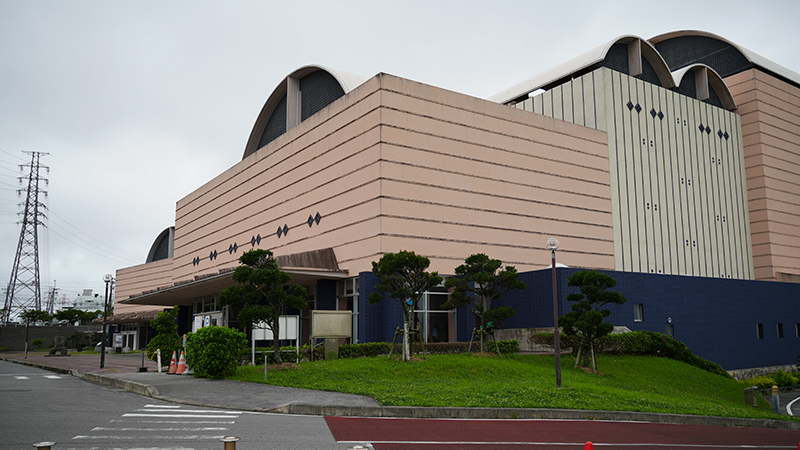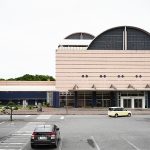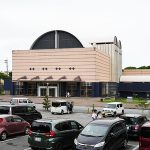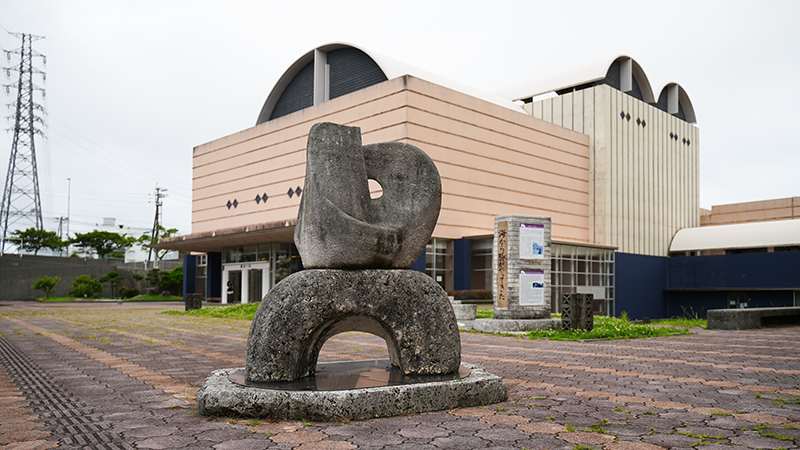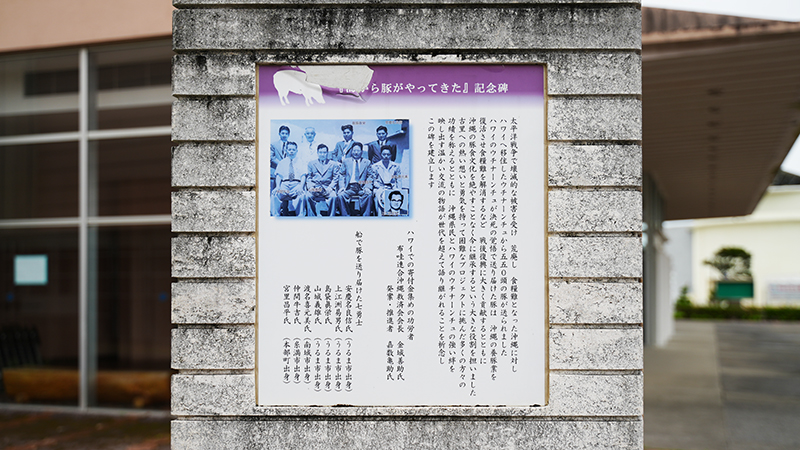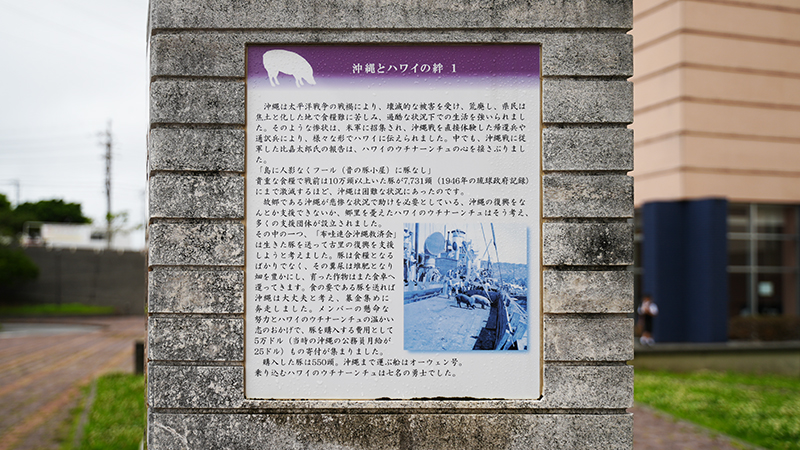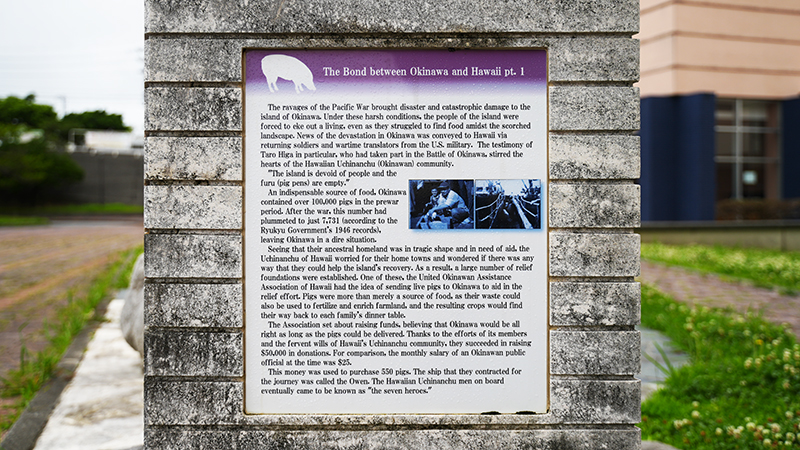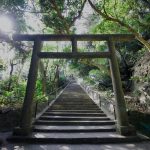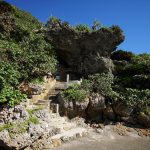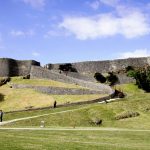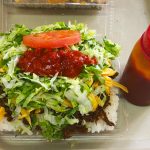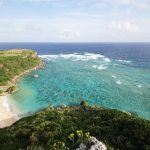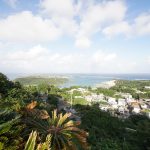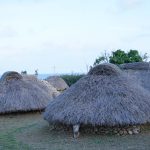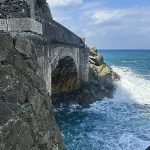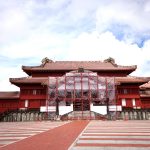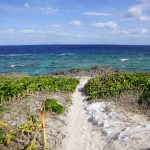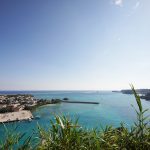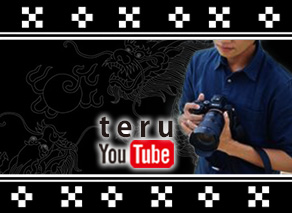うるま市民芸術劇場はクラシックを中心に、演劇や各種コンサートにも対応可能な響ホールです。
コンパクトながら音響・照明・舞台機構が充実した燈ホールの2つからなる劇場があります。
アクティブエリアと同等の広さを備えたリハーサル室も有し、利便性も申し分ありません。
抜群のサービスで舞台芸術創造活動をサポートもしてくれます。
詳しくは、うるま市民芸術劇場にてお問い合わせください。
うるま市民芸術劇場の碑石
うるま市民芸術劇場の周りには碑石が多数存在します。
そこで、知る人ぞ知る、沖縄戦後の英雄と豚のストーリーもあります。
海から豚がやってきた記念碑
「海から豚がやってきた」の話を御存知でしょうか。
知っている方も多いと思いますが、大筋は以下のような話です。
先の大戦で荒廃し、食糧難で耐え難い状況下にあった沖縄県に、遠くハワイの沖縄県系の皆様が募金で集めたお金で購入した豚550頭を送ったという話です。
この話は、沖縄県民とハワイのウチナーンチュの堅い絆を象徴する出来事であると同時に、相互支援、相互扶助の精神を教えさとす逸話であります。
甲板上の豚また、日頃から食していて、沖縄の代表的食文化の一つである、豚食文化を途切れることなく、今に定着させた史実でもあります。
これまで、この話は教科書やミュージカル、新聞記事などをとおして、広く県民に伝播しております。
しかし、経年により風化させないためにも、この物語を継承し、後世に歴史と意義を形として残したいとの強い思いで、「海から豚がやってきた」記念碑建立実行委員会を発足し、平成28年3月5日にうるま市のうるま市民芸術劇場の敷地内に記念碑を建立しました。
七勇士の勇気と故郷愛
船に乗り込み、嵐や機雷の恐怖にも負けず故郷沖縄へ豚を届けたのは写真にある七勇士の県系人でした。
彼らが数々の困難をものともせず、母県に豚を届けたのは、荒廃し食糧難で苦しむ古里を助けたい一心からでした。
七勇士その詳細は下記の碑文及び説明文でご覧になれます。
「海から豚がやってきた」記念碑
太平洋戦争で壊滅的な被害を受け荒廃し食糧難となった沖縄に対しハワイへ移住したウチナーンチュから550頭の豚が送られましたハワイのウチナーンチュが決死の覚悟で送り届けた豚は沖縄の養豚業を復活させ食糧難を解消するなど戦後復興に大きく貢献するとともに沖縄の豚食文化を絶やすことなく今に継承するという大きな役割を担いました古里への熱い想いと勇気を持って困難なプロジェクトに挑んだ多くの方々の功績を称えるとともに沖縄県民とハワイのウチナーンチュの強い絆を映し出す温かい交流の物語が世代を超えて語り継がれることを祈念しこの碑を建立します
ハワイでの寄付金集めの功労者布哇連合沖縄救済会会長金城善助氏発案・推進者嘉数亀助氏
船で豚を送り届けた七勇士
安慶名良信氏(うるま市出身)
上江洲易男氏(うるま市出身)
島袋眞栄氏(うるま市出身)
山城義雄氏(うるま市出身)
渡名喜元美氏(南城市出身)
仲間牛吉氏(糸満市出身)
宮里昌平氏(本部町出身)
“Pigs from the Sea” Commemorative Monument
The Pacific War brought calamity and starvation to the island of Okinawa.
This monument is erected in memory of the 550 pigs delivered to Okinawa by Uchinanchu (Okinawan) immigrants residing in Hawaii.
These pigs, which our Uchinanchu brethren in Hawaii risked their lives to deliver, helped revive the Okinawan pig farming industry and solve the food shortage, greatly contributing to the island’s postwar recovery.
They also played a large role in ensuring that the Okinawan tradition of consuming pork could be carried on to future generations.
This monument honors the men and women of Hawaii who, with love for their ancestral homeland and courage in their hearts, undertook such a monumental task and whose efforts yielded such incredible results.
It was constructed in the hopes that this magnificent story, which shows the strength of the bonds between the people of Okinawa and their Uchinanchu brothers and sisters in Hawaii, will continue to be passed down across generations.
Chief Fundraisers from Hawaii:
Zensuke Kinjo, President of the United Okinawan Assistance Association of Hawaii
Kamesuke Kakazu, Initial Planner and Promoter
The Seven Heroes who Voyaged to Okinawa:
Ryoshin Agena (native of Uruma City)
Yasuo Uezu (native of Uruma City)
Shinei Shimabukuro (native of Uruma City)
Yoshio Yamashiro (native of Uruma City)
Genbi Tonaki (native of Nanjo City)
Ushikichi Nakama (native of Itoman City)
Shohei Miyazato (native of the town of Motobu)
海から豚がやってきたストーリー
沖縄は太平洋戦争の戦禍により、壊滅的な被害を受け、荒廃し、県民は焦土と化した地で食糧難に苦しみ、過酷な状況下での生活を強いられました。
そのような惨状は、米軍に招集され、沖縄戦を直接体験した帰還兵や通訳兵により、様々な形でハワイに伝えられました。
中でも、沖縄戦に従軍した比嘉太郎氏の報告は、ハワイのウチナーンチュの心を揺さぶりました。
「島に人影なくフール(昔の豚小屋)に豚なし」貴重な食糧で戦前は 10 万頭以上いた豚が 7,731 頭(1946 年の琉球政府記録)にまで激減するほど、沖縄は困難な状況にあったのです。
故郷である沖縄が悲惨な状況で助けを必要としている、沖縄の復興をなんとか支援できないか、郷里を憂えたハワイのウチナーンチュはそう考え、多くの支援団体が設立されました。
その中の一つ、「布哇連合沖縄救済会」は生きた豚を送って古里の復興を支援しようと考えました。
豚は食糧となるばかりでなく、その糞尿は堆肥となり畑を豊かにし、育った作物はまた食卓へ還ってきます。
食の要である豚を送れば沖縄は大丈夫と考え、募金集めに奔走しました。
メンバーの懸命な努力とハワイのウチナーンチュの温かい志のおかげで、豚を購入する費用として5万ドル(当時の沖縄の公務員月給が25ドル)もの寄付が集まりました。
購入した豚は550 頭。沖縄まで運ぶ船はオーウェン号。乗り込むハワイのウチナーンチュは七名の勇士でした。
1948年8月31日、オーウェン号は沖縄に向けて出港しましたが、激しい暴風雨や高波に襲われ、航海はまさに命がけとなりました。
また、戦争で残された洋上に浮遊する機雷を避ける航路をとったため、航路が長くなり、3週間を過ぎた頃から乗組員の飲料水や豚の飼料が底をつきかけました。
それでも七勇士は郷里を愛する強い意志で結束し、沖縄を目指しました。
様々な困難を乗り越え、迎えた28日目の9月27日、ついに沖縄の島影が見えました。
オーウェン号はうるま市勝連平敷屋のホワイトビーチに到着しました。
ハワイのウチナーンチュが決死の覚悟で送り届けた豚は、広く公平に分配され、4年後には10万頭になり、沖縄県の養豚業を復活させ、食糧難を解消するなど、戦後復興に大きく貢献しました。
今もこうして豚食が沖縄の代表的な食文化として継承され、沖縄の日常の食卓にのぼることは、この時のハワイからの豚のおかげです。
ハワイを中心に始まったこの動きは、やがて米本土や南米へ広がり、世界中のウチナーンチュから温かい支援が沖縄へ届きました。
このように我々は多くの人に支えられて生きていることを忘れてはなりません。
この史実はうるま市によりミュージカルとして上演され、また教科書や学習発表会など学校の教材として活用されるなど、次代を担う子ども達に語り継がれております。
「海から豚がやってきた」記念碑建立実行委員会では、この史実をより多くの方々に知ってもらうため、県や関係市町村、畜産関係者と一丸となって記念碑建立の募金を広く募りました。
その結果、趣旨に賛同された個人、団体、企業など多くの皆様から寄付をいただき、この記念碑建立は実現することができました。
平成28年3月5日「海から豚がやってきた」記念碑建立実行委員会
Story of pigs coming from the sea
The Bond between Okinawa and Hawaii
The ravages of the Pacific War brought disaster and catastrophic damage to the island of Okinawa.
Under these harsh conditions, the people of the island were forced to eke out a living, even as they struggled to find food amidst the scorched landscape.
News of the devastation in Okinawa was conveyed to Hawaii via returning soldiers and wartime translators from the U.S. military.
The testimony of Taro Higa in particular, who had taken part in the Battle of Okinawa, stirred the hearts of the Hawaiian Uchinanchu (Okinawan) community.
“The island is devoid of people and the furu (pig pens) are empty.”
An indispensable source of food, Okinawa contained over 100,000 pigs in the prewar period. After the war, this number had plummeted to just 7,731 (according to the Ryukyu Government’s 1946 records), leaving Okinawa in a dire situation.
Seeing that their ancestral homeland was in tragic shape and in need of aid, the Uchinanchu of Hawaii worried for their home towns and wondered if there was any way that they could help the island’s recovery. As a result, a large number of relief foundations were established.
One of these, the United Okinawan Assistance Association of Hawaii had the idea of sending live pigs to Okinawa to aid in the relief effort.
Pigs were more than merely a source of food, as their waste could also be used to fertilize and enrich farmland, and the resulting crops would find their way back to each family’s dinner table.
The Association set about raising funds, believing that Okinawa would be all right as long as the pigs could be delivered. Thanks to the efforts of its members and the fervent wills of Hawaii’s Uchinanchu community, they succeeded in raising $50,000 in donations. For comparison, the monthly salary of an Okinawan public official at the time was $25.
This money was used to purchase 550 pigs. The ship that they contracted for the journey was called the Owen.
The Hawaiian Uchinanchu men on board eventually came to be known as “the seven heroes.” The Owen departed for Okinawa on August 31, 1948, and the voyage became a life and death struggle as the ship was assaulted by raging storms and battered by tall waves. The journey was further delayed by the need to take a roundabout route in order to avoid sea mines left over from the war.
By the 3 week mark, the passenger’s water supply and the feed for the pigs was almost completely depleted.
In spite of these setbacks, the seven heroes, united in their love for their homeland, persevered towards Okinawa. After 28 grueling days at sea, the passengers finally caught sight of the Okinawan islands on September 27.
The Owen made landfall on White Beach, in the Katsuren Heshikiya region of Uruma City. The 550 pigs which the Hawaiian Uchinanchu had risked their very lives to deliver were evenly distributed among the Okinawan public, and through breeding swelled to 100,000 in the span of 4 years. This revitalized the Okinawan pig farming industry and solved the island’s food shortage, greatly contributing to its postwar recovery.
Okinawa’s tradition of consuming pork was successfully passed down, and pork continues to be a staple of the Okinawan diet to this day.
This is all thanks to those 550 pigs that came from Hawaii.
This movement which began in Hawaii eventually spread to the American mainland and South America, and in time aid began to pour into Okinawa from all across the globe. We Okinawans must never forget that it was thanks to the support of so many people that we were able to survive.
The story of the pigs was turned into a musical by the city of Uruma, and it is also taught in textbooks and school festivals across Okinawa. In this way, we ensure that the story is passed down to the children of the next generation who hold the future of our islands in their hands.
In order to spread the knowledge of this incredible true story to as many people as possible, the “Pigs from the Sea” Commemorative Monument Construction Executive
Committee collected funds from the prefectural government, various municipalities, and related individuals in the livestock industry for construction of this monument. We
were able to make this project a reality thanks to the donations of the individuals, organizations, and companies who kindly supported our mission.
March 5, 2016 “Pigs From the Sea” Commemorative Monument Construction Executive Committee
物語の現地でもある、平敷屋タキノーもご覧ください
ホワイトビーチが一望できる平敷屋タキノー!豚はここからやってきた!
平敷屋タキノー
| 名称 | うるま市民芸術劇場 |
|---|---|
| 住所 | 〒904-2226 沖縄県うるま市仲嶺175 |
| 電話番号 | TEL:098-973-4400 FAX:098-973-4444 |
| 休館日 | 月曜・火曜・12/29~1/3 |
| 駐車場 | あり |
| 参考 | リハーサル室:1 / 楽屋:8 / 応接室:1 / その他室数:1 / 残響可変、プロセニアム可変 |

